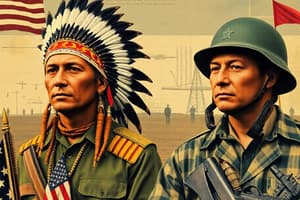Podcast
Questions and Answers
What was one method employed by American forces to combat suspected insurgents?
What was one method employed by American forces to combat suspected insurgents?
- Establishing peace treaties with enemy factions
- Providing humanitarian aid to villages
- Torturing suspected guerrillas for information (correct)
- Negotiation with local leaders
How did the public perception of military actions during the Vietnam conflict differ from earlier conflicts, such as the Indian wars?
How did the public perception of military actions during the Vietnam conflict differ from earlier conflicts, such as the Indian wars?
- The public supported total extermination of the enemy.
- Public condemnation of military brutality was prevalent. (correct)
- Press reports were largely favorable to the military.
- There was widespread indifference towards military actions.
What action did Wheaton take after his companies were ambushed?
What action did Wheaton take after his companies were ambushed?
- He increased diplomatic efforts with local communities.
- He ordered the evacuation of civilians.
- He retreated to a safer area.
- He ordered the burning of every town and village within twelve miles. (correct)
What sentiment did American soldiers feel towards public condemnation of their actions?
What sentiment did American soldiers feel towards public condemnation of their actions?
What was the primary challenge faced by U.S. military leaders during the insurgent war?
What was the primary challenge faced by U.S. military leaders during the insurgent war?
What was the consequence for refusing to comply with the order to return home by 7 P.M.?
What was the consequence for refusing to comply with the order to return home by 7 P.M.?
Which method of torture involved pouring liquid into a victim's mouth?
Which method of torture involved pouring liquid into a victim's mouth?
The phrase 'no quarter' in relation to the soldiers' attitude suggests what intention?
The phrase 'no quarter' in relation to the soldiers' attitude suggests what intention?
What was a common belief among soldiers regarding Filipinos compared to Plains Indians?
What was a common belief among soldiers regarding Filipinos compared to Plains Indians?
What punitive action was commonly taken against soldiers who committed acts of brutality?
What punitive action was commonly taken against soldiers who committed acts of brutality?
What significant outcome did the anti-imperialist press aim to achieve by reporting on American brutality?
What significant outcome did the anti-imperialist press aim to achieve by reporting on American brutality?
What was one result of the reprisals against civilians during the military campaigns?
What was one result of the reprisals against civilians during the military campaigns?
What was one punishment received by soldiers who were convicted of torture?
What was one punishment received by soldiers who were convicted of torture?
Flashcards are hidden until you start studying
Study Notes
American Brutality in the Philippines
- American soldiers compared Filipinos to Native Americans, reflecting a similar attitude of violence and prejudice.
- Reports of American brutality against Filipinos, including torture and extrajudicial killings, were frequent.
- The text describes methods of torture used by American soldiers such as the water cure and the rope cure.
- The text highlights a stark contrast between American attitudes toward Native Americans, where brutality was accepted, and Filipinos, where public condemnation of brutality began to emerge.
- While some soldiers were court-martialed for atrocities, punishments were generally lenient, adding to the sense of betrayal felt by soldiers who felt their actions were justified.
- The text connects the events in the Philippines to later conflicts in Southeast Asia, citing the use of torture and the development of terrorist methods.
Filipino Responses
- Filipinos used guerilla tactics and booby traps against American forces.
- Filipino resistance and the tactics they employed eventually led to the loss of US public support for the war.
Key Figures
- Corporal Sam Gillis, 1st California Volunteer Regiment
- General Lloyd Wheaton
Studying That Suits You
Use AI to generate personalized quizzes and flashcards to suit your learning preferences.




